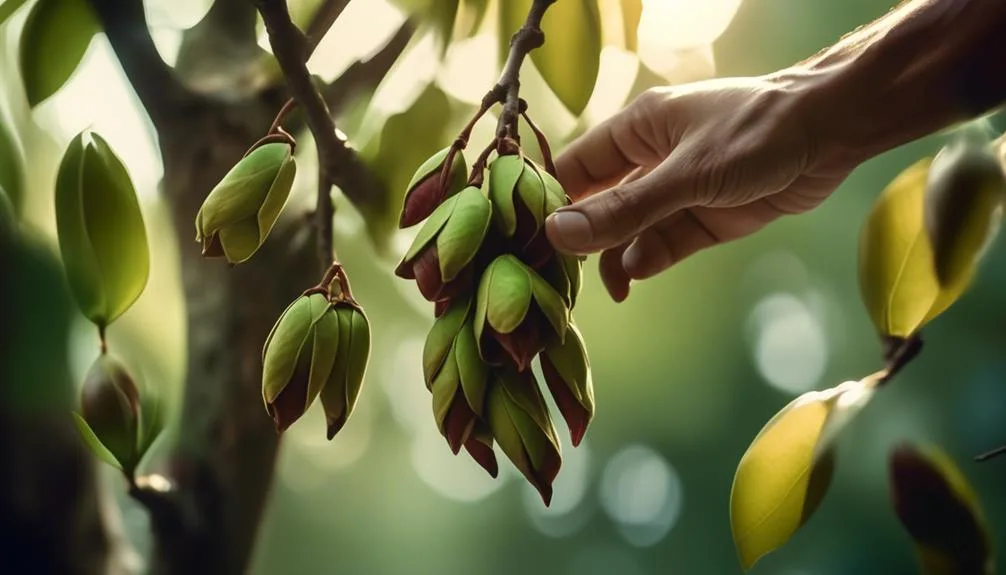Harvesting magnolia seeds requires patience and the right techniques. The process is crucial to unlocking the potential of these treasures.
Beneath the grand magnolia tree, with its beautiful leaves and fragrant blossoms, lies the promise held within its seed pods. Timing and specific methods are essential for effective gathering.
Let's explore the best ways to harvest magnolia seeds and discover their hidden potential.
Timing for Harvesting Magnolia Seeds
Timing for harvesting magnolia seeds is crucial for ensuring the highest quality and viability of the seeds for propagation. To determine the ideal time for harvest, consider the seed maturity.
Mature magnolia seeds are usually red or orange when fully ripe, and the seed pods will begin to split open, revealing the bright seeds inside. Optimal conditions for harvesting include a dry day when the seeds aren't wet from rain or dew.
It's best to collect the seeds in the morning when temperatures are cooler, as this helps preserve their viability. Selecting seeds at the right time guarantees the best chances of successful propagation, ultimately leading to healthy and vibrant magnolia trees in your garden.
Identifying Ripe Magnolia Seed Pods
To identify ripe magnolia seed pods, look for vivid red or orange colors and split-open pods revealing the bright seeds inside. When inspecting seed pods, consider the following ripeness indicators:
- Color: Ripe magnolia seed pods often display vibrant red or orange hues, signaling maturity and readiness for harvesting. Visualize the pod as a signal of ripeness, akin to a traffic light turning from green to red.
- Pod Opening: Split-open pods indicate that the seeds inside are fully developed and ready for collection. Imagine the pod as a treasure chest, the split revealing the valuable seeds within.
Techniques for Collecting Magnolia Seeds
When collecting magnolia seeds, carefully select pods that have reached full maturity and are beginning to split open, ensuring the best chances for successful germination. Gently hold the pod and twist it to release the seeds into a container.
Avoid collecting seeds that are still enclosed in green, unripe pods as they're unlikely to germinate. Once you have gathered the seeds, clean off any remaining pulp or debris and allow them to air dry for a few days.
It's important to store the seeds in a cool, dry place until you're ready to use them for propagation. By following these techniques, you can ensure that the collected magnolia seeds are in optimal condition for successful seed germination and propagation methods.
Cleaning and Storing Magnolia Seeds
After carefully selecting mature magnolia pods and releasing the seeds into a container, the next important step is to clean off any remaining pulp or debris and air dry the seeds for a few days before storing them in a cool, dry place for future propagation.
To ensure successful seed germination, follow these steps:
- Cleaning the seeds: Gently rinse the seeds in water to remove any remaining pulp or debris, then lay them out to air dry for 3-5 days.
- *Visualize the process:* Picture the seeds being carefully rinsed and laid out to dry, ensuring they're completely free of any remaining pulp or debris.
- Storing the seeds: Once dry, store the magnolia seeds in a breathable container such as a paper bag or perforated plastic bag in a cool, dry place to maintain their viability for future propagation.
Tips for Successful Magnolia Seed Harvesting
For successful magnolia seed harvesting, carefully choose mature pods and gently extract the seeds for propagation. Look for pods that have turned from green to brown, indicating maturity. When extracting the seeds, handle them with care to avoid damaging the delicate embryo inside.
After collection, it's important to promote seed germination by preparing the soil properly. Choose a well-draining potting mix and fill containers with it. Plant the seeds at a depth of about half an inch, and keep the soil consistently moist but not waterlogged.
Place the containers in a warm, sunny location, and monitor the moisture levels regularly. With the right soil preparation and optimal growing conditions, you'll soon witness the magic of seed germination as your magnolia seeds sprout and grow into beautiful plants.
Conclusion
Now you're equipped with the know-how to harvest magnolia seeds and cultivate your own beautiful trees.
By timing the harvest, identifying ripe seed pods, and using proper collection and storage techniques, you can nurture these stunning blooms in your garden for years to come.
Happy gardening, and may your magnolia trees bring you joy and beauty.

My interest in trees started when I first saw the giant sequoias in Yosemite.
I was a teenager then, and I remember thinking, “I need to learn more about this.”
That moment stuck with me.
A few years later, I went on to study forestry at Michigan Tech.
Since graduating, I’ve worked in a mix of hands-on tree care and community education.
I’ve spent over ten years helping people understand how to plant, maintain, and protect the trees in their neighborhoods.
I don’t see trees as just part of the landscape.
They are living things that make a real difference in our daily lives.
